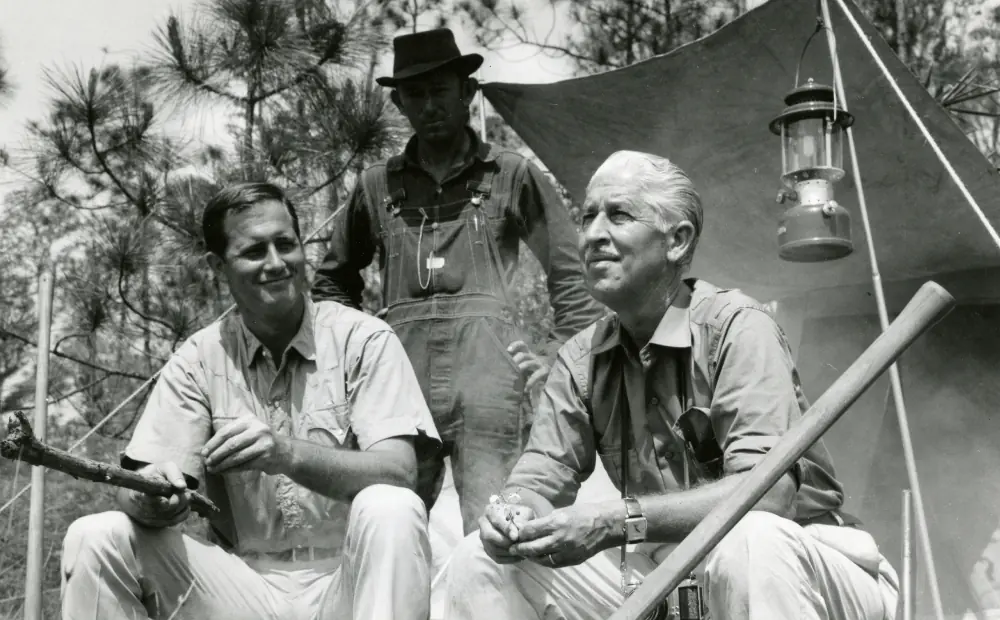0:01
Wild Kingdom has been at the forefront of animal photography for over 60 years.
0:07
In the early days, Marlon Perkins and Jim Fowler traveled with large, heavy film cameras and waited days or weeks to capture iconic moments.
0:20
Decades later, our cameras are small and portable, capable of endless recording.
0:28
OK, all right.
0:29
Well, maybe.
0:30
Maybe.
0:31
Maybe.
0:31
You never know.
0:32
What these things.
0:33
It's a kitten.
0:39
That's a kitten.
0:41
These technological advances are revolutionizing our understanding of wild animal behaviors and helping to protect our planet's most vulnerable species.
0:51
Faded Promote underwater video station.
0:54
I've never seen anybody record this kind of close up data about first.
1:00
One such animal that has benefited from these new technologies is the vulnerable polar bear.
1:06
We are heading out to Churchill, Manitoba to discover how new observation techniques have helped polar bear preservation and see if we can spot one in the wild.
1:16
Oh, look at the sign.
1:18
Oh, look, it says there's a curfew.
1:20
A bear curfew.
1:22
I guess he didn't want us to keep the bears up at night.
1:25
Churchill is known as the polar bear capital of the world.
1:29
To find out why, we joined forces with renowned polar bear tracker Dennis Campare.
1:35
Welcome to Churchill.
1:36
Have you got everything we do?
1:38
Let's go find a bear.
1:39
Let's go find some bears In the winter.
1:42
Temperatures in Churchill can plunge to less than -15°F.
1:48
Thanks for rock'n'roll.
1:49
Luckily, we're here for a summer adventure and it's a balmy 50°.
1:57
Why is Churchill the polar bear capital of the world?
2:00
We have The influx of the Churchill River that empties into the Hudson Bay dilutes the salt water content in the Bay.
2:08
Therefore it freezes quicker than anywhere else in the Bay.
2:12
So the bears know that, so they travel to this spot.
2:15
So they get an advantage of getting out hunting seal on us using ice as a platform.
2:21
Most polar bear populations migrate N with the sea ice as it recedes.
2:26
But in Churchill, where the summer ice naturally melts, they're forced to come ashore to rest, which hopefully gives us the opportunity to observe one for ourselves.
2:38
We'll be observing polar bears using real time video from a drone.
2:42
This technology has revolutionized animal conservation, especially for large mammals that you definitely want at a safe distance.
2:52
Just keep your eyes open.
2:53
Does that look like a bear to you?
2:55
Yeah, that does.
2:56
So you start very far away and high and get them used to the noise.
3:00
You don't want to spook them.
3:01
Look right over here.
3:02
She's coming down to take a dip right down the water's hands.
3:05
Look at this, waiting in that water and holding off her belly, getting her body temperature back down to something comfortable.
3:14
So what's the best way to, you know, observe its behavior and kind of see what it's up to?
3:21
If the bear's active on the rocks, we wouldn't want to go on land when he's roaming around.
3:25
The boat's the best place to stay.
3:28
One of the things that we're concerned about with polar bears is changing ecosystems, changing climates.
3:33
You've lived here your whole life and you've seen so many of these changes take place.
3:38
What's going on with bears now, and how do you think you're doing?
3:42
The ice is disappearing.
3:44
It's on a downward curve for sure.
3:46
So and then that, there lies the problem.
3:49
If the ice gets any thinner, it's a whole bunch of crazy things happens to the bears.
3:54
The most common thing we're hearing is we talk to researchers and scientists is that we still have so much more to learn.
4:00
Oh, man, a polar bear can teach you here.
4:03
The newest thing every day if you had the opportunity to watch it.
4:07
I mean, this alone is kind of like a peek into the secret world of a polar bear right here in and of itself.
4:15
The technology that we have available allows us to just get to know these animals in a way that we've never been able to before.
4:22
That's the foundation of science, is observation.
4:25
Being able to be so darn close to polar bears and see them doing so well, that's the best kind of motivation for conservation.
4:35
You want to see the animal thriving and just want to keep it that way.












